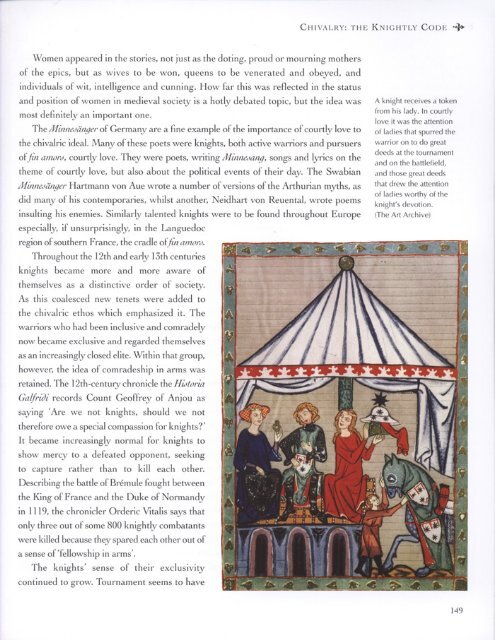Osprey - General Military - Knight - The Warrior and ... - Brego-weard
Osprey - General Military - Knight - The Warrior and ... - Brego-weard
Osprey - General Military - Knight - The Warrior and ... - Brego-weard
Create successful ePaper yourself
Turn your PDF publications into a flip-book with our unique Google optimized e-Paper software.
Women appeared in the stories, not just as the doting, proud or mourning mothers<br />
of the epics, but as wives to be won, queens to be venerated <strong>and</strong> obeyed, <strong>and</strong><br />
individuals of wit, intelligence <strong>and</strong> cunning. How far this was reflected in the status<br />
<strong>and</strong> position of women in medieval society is a hotly debated topic, but the idea was<br />
most definitely an important one.<br />
<strong>The</strong> Minnesanger of Germany are a fine example ol the importance of courtly love to<br />
the chivalric ideal. Many ol these poets were knights, both active warriors <strong>and</strong> pursuers<br />
of jin amors, courtly love. <strong>The</strong>y were poets, writing /Minnesang, songs <strong>and</strong> lyrics on the<br />
theme of courtly love, but also about the political events of their day. <strong>The</strong> Swabian<br />
Minnedtinger Hartmann von Aue wrote a number of versions of the Arthurian myths, as<br />
did many of his contemporaries, whilst another, Neidhart von Reuental, wrote poems<br />
insulting his enemies. Similarly talented knights were to be found throughout Europe<br />
especially, if unsurprisingly, in the Languedoc<br />
region of southern France, the cradle of fin amors.<br />
Throughout the 12th <strong>and</strong> early 13th centuries<br />
knights became more <strong>and</strong> more aware of<br />
themselves as a distinctive order of society.<br />
As this coalesced new tenets were added to<br />
the chivalric ethos which emphasized it. <strong>The</strong><br />
warriors who had been inclusive <strong>and</strong> comradely<br />
now became exclusive <strong>and</strong> regarded themselves<br />
as an increasingly closed elite. Within that group,<br />
however, the idea of comradeship in arms was<br />
retained. <strong>The</strong> 12th-century chronicle the H'utoria<br />
GaLfridi records Count Geoffrey of Anjou as<br />
saying 'Are we not knights, should we not<br />
therefore owe a special compassion for knights?'<br />
It became increasingly normal for knights to<br />
show mercy to a defeated opponent, seeking<br />
to capture rather than to kill each other.<br />
Describing the battle of Bremule fought between<br />
the King of France <strong>and</strong> the Duke of Norm<strong>and</strong>y<br />
in 1119, the chronicler Orderic Vitalis says that<br />
only three out of some 800 knightly combatants<br />
were killed because they spared each other out of<br />
a sense of 'fellowship in arms'.<br />
<strong>The</strong> knights' sense of their exclusivity<br />
continued to grow. Tournament seems to have<br />
CHIVALRY: THE KNIGHTLY CODE -







